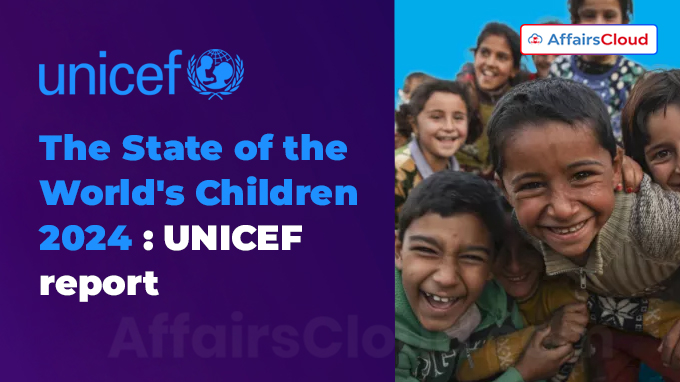
According to the State of the World’s Children (SOWC 2024) report which is a global flagship report of United Nations Children’s Emergency Fund (UNICEF), titled “The Future of Childhood in a Changing World”, the global child population will stabilize at around 2.3 billion by 2050, with a significant shift in regional distributions.
- The report was released on the occasion of World Children’s Day (20th November, 2024) in New Delhi, Delhi.
About SOWC 2024:
i.The report is published annually since 1989 by UNICEF.
ii.The report has examined three megatrends that will potentially affect children’s lives between now and 2050: demographic shifts, climate and environmental crisis, and frontier technologies.
iii.The future scenarios analysed by the UNICEF in partnership with Wittgenstein Centre for Demography and Global Human Capital provides in-depth information into how these megatrends will shape childhood in 2050.
iv.The key findings of the report are derived from scenario analysis of 7 key areas: child survival and life expectancy; climate and environmental hazards; socio-economic conditions; education; gender equality; conflict exposure; and urbanization.
Key Findings related to 3 Megatrends:
i.Demographic shifts: As per the report, South Asia will remain one of the regions in the world with the largest child populations, along with Eastern and Southern Africa as well as West and Central Africa.
- The report has projected that the share of children in the population will decrease in every region, for instance: the share of children is expected to decline below 40% in Africa compared to about 50% in 2000s.
- It is followed by decline below 19% in East Asia, Western Europe, North America, and among various High Income Countries (HICs) such as: Australia, the Republic of South Korea and Singapore.
ii.Climate and Environmental Crisis: Globally, nearly 1 billion children already face extreme vulnerability to climate and environmental hazards and this figure is estimated to increase dramatically without significant interventions.
- Children’s developing bodies are particularly vulnerable to pollution and extreme weather, with their brains, lungs, and immune systems at even before birth.
- Since 2022, 400 million children worldwide have experienced school closures due to extreme weather conditions.
iii.Frontier Technologies: It includes Artificial Intelligence (AI), neurotechnology, next-generation renewable energy and mRNA vaccine breakthroughs could help to improve childhood in future.
- However, over 95% of people in high-income countries are internet connected; only 26% in low-income countries have access.
- This digital exclusion threatens to augment existing inequalities, especially in regions with rapidly growing child populations such as those in Africa.
Other Key Findings:
i.Child survival and life expectancy: Globally, newborn survival rates increases by 4% points from the 2000s to over 98%.
- The chances of a child surviving to the age of 5 increases to 99.5% (up by 1% points from the 2000s).
- Life expectancy for girls and boys increases from 70 years and 66 in the 2000s to 81 years and 76, respectively.
ii.Climate and Environmental Hazards: The report has projected that children are expected to be exposed to extreme weather conditions at significantly higher rates by the 2050s compared with those in 2000s like:
- Nearly 8 times more children are estimated to be exposed to extreme heatwaves, 3.1 times more to river floods, 1.7 times more to wildfires, 1.3 times more to droughts, and 1.2 times more to tropical cyclones.
iii.Socio-economic conditions: As per the report, 23% of the global children are projected to live in 28 low-income countries in the 2050s compared to 11% in the 2000s.
- Also, the Gross Domestic Product (GDP) per capita is estimated to more than double in East Asia and the Pacific and South Asia from 2020s to the 2050s.
iv.Education: The report has projected that 95.7% of children are expected to have at least a primary education (up from 80% in the 2000s) by the 2050s, while 77% are estimated to have at least an upper secondary education (up from 40% in the 2000s).
- Eastern and Southern Africa and West and Central Africa are required to another 31 million teachers by the 2050s.
v.Conflict Exposure: As per the report, the number of children living in the conflict areas is estimated to decrease from over 833 million in the 2000s to 622 million in the 2050s.
- However, the number of children at risk of facing prolonged subnational conflict in Eastern and South Africa region is projected to increase from 71 million (in the 2000s) to 97.8 million (in the 2050s), and from 5.1 million to 69 million in West and Central Africa.
vi.Urbanisation: The report has estimated that approximately 60% of children globally will live in urban settings in the 2050s, up from 44% in the 2000s.
- Latin America and the Caribbean are projected to constitute the highest share of global children in urban areas (84%), followed by Eastern and Southern Africa (45%).
India-Specific:
i.The report revealed that up to 34 million people in India could be impacted by extreme river flooding by the 2040s, while coastal floods are projected to affect 18 million by the 2070s.
About United Nations Children’s Fund (UNICEF):
Executive Director- Catherine Mary Russell
Headquarters- New York, the United States of America (USA)
Established- 1946




